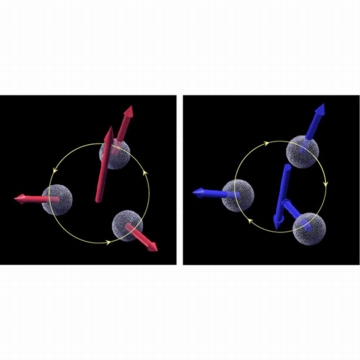Home > Press > A particular spin topology in solid-state materials has a strong influence on thermally generated electron transport
 |
| Figure 1: Schematic representation of spin chirality. Reversing one of the spins (right) results in reversing the spin chirality. |
Abstract:
Chirality, or handedness—where an object cannot be superimposed on its mirror image—is found in many physical systems. In the case of electron spin—the smallest magnetic field generated by an electron—the chirality shown by some compounds can be quantified by the solid angle subtended by three nearby spins, and can be controlled by the application of a magnetic field (Fig. 1).
A particular spin topology in solid-state materials has a strong influence on thermally generated electron transport
Japan | Posted on July 25th, 2008Shigeki Onoda from the RIKEN's Advanced Science Institute (formerly the Discovery Research Institute), Wako, and colleagues from Japan and Hungary have studied the effect of spin chirality on the transport properties in solid-state materials1. Spin chirality has been shown to have an effect on other transport properties, for example in the so-called anomalous Hall effects2, in which no temperature gradient is involved.
"Spin chirality bears a fictitious magnetic field and bends the electron motion driven by the temperature gradient, [thus] introducing a transverse current," explains Onoda. "The direction in which the electron motion is bent depends on the sign of the spin chirality."
In their study, the researchers focussed on whether spin chirality influences the Nernst effect, which describes the generation of an electric current in the direction perpendicular to that of a temperature gradient.
Onoda and colleagues studied a series of compounds named pyrochlore molybdates. Because some members of this family show spin chirality and others do not, they could make direct comparisons.
The comparisons between results on different compounds highlighted the effect of the spin chirality. Specifically, compounds with spin chirality showed an anomalous Nernst effect in a specific temperature range (20-30 K (-253.15- -243.15 °C)), while a compound with no spin chirality showed no effect.
The importance of the result goes beyond the specific case of the class of materials studied. "The observation of this fundamental phenomenon has revealed that a fairly large fictitious magnetic field can be generated in materials by controlling the low-energy degrees of freedom of the spin chirality," says Onoda. "The sign of the spin chirality controls that of the transverse heat/electric current. This is unlike the usual cases of Nernst effects, where [the sign of the transverse current] is exclusively determined by that of the temperature gradient and the applied magnetic field or the magnetization in particular materials." According to the researchers, their study reveals that spin chirality is really a new and promising basic quantity in electron transport phenomena.
Reference
1. Hanasaki, N., Sano, K., Onose, Y., Ohtsuka, T., Iguchi, S., Kézsmárki, I., Miyasaka, S., Onoda, S., Nagaosa, N. & Tokura, Y. Physical Review Letters 100, 106601 (2008). | article |
2. Taguchi, Y., Oohara, Y., Yoshizawa, H., Nagaosa, N. & Tokura, Y. Spin chirality, Berry phase, and anomalous Hall effect in a frustrated ferromagnet. Science 291, 2573-2576 (2001).
####
For more information, please click here
Copyright © Riken
If you have a comment, please Contact us.Issuers of news releases, not 7th Wave, Inc. or Nanotechnology Now, are solely responsible for the accuracy of the content.
| Related News Press |
Physics
![]() Simulating magnetization in a Heisenberg quantum spin chain April 5th, 2024
Simulating magnetization in a Heisenberg quantum spin chain April 5th, 2024
News and information
![]() Simulating magnetization in a Heisenberg quantum spin chain April 5th, 2024
Simulating magnetization in a Heisenberg quantum spin chain April 5th, 2024
![]() NRL charters Navy’s quantum inertial navigation path to reduce drift April 5th, 2024
NRL charters Navy’s quantum inertial navigation path to reduce drift April 5th, 2024
![]() Discovery points path to flash-like memory for storing qubits: Rice find could hasten development of nonvolatile quantum memory April 5th, 2024
Discovery points path to flash-like memory for storing qubits: Rice find could hasten development of nonvolatile quantum memory April 5th, 2024
Discoveries
![]() Chemical reactions can scramble quantum information as well as black holes April 5th, 2024
Chemical reactions can scramble quantum information as well as black holes April 5th, 2024
![]() New micromaterial releases nanoparticles that selectively destroy cancer cells April 5th, 2024
New micromaterial releases nanoparticles that selectively destroy cancer cells April 5th, 2024
![]() Utilizing palladium for addressing contact issues of buried oxide thin film transistors April 5th, 2024
Utilizing palladium for addressing contact issues of buried oxide thin film transistors April 5th, 2024
Announcements
![]() NRL charters Navy’s quantum inertial navigation path to reduce drift April 5th, 2024
NRL charters Navy’s quantum inertial navigation path to reduce drift April 5th, 2024
![]() Discovery points path to flash-like memory for storing qubits: Rice find could hasten development of nonvolatile quantum memory April 5th, 2024
Discovery points path to flash-like memory for storing qubits: Rice find could hasten development of nonvolatile quantum memory April 5th, 2024
|
|
||
|
|
||
| The latest news from around the world, FREE | ||
|
|
||
|
|
||
| Premium Products | ||
|
|
||
|
Only the news you want to read!
Learn More |
||
|
|
||
|
Full-service, expert consulting
Learn More |
||
|
|
||








